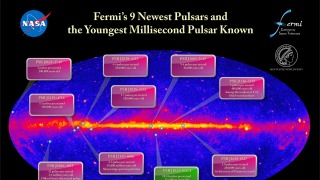Universe
ID: 10361
A pulsar is a rapidly spinning and highly magnetized neutron star, the crushed core left behind when a massive sun explodes. Most were found through their pulses at radio wavelengths, which are thought to be caused by narrow, lighthouse-like beams emanating from the star's magnetic poles.
Pulsars Emit Gamma-rays from Equator
When it comes to gamma-rays, pulsars are no longer lighthouses. A new class of gamma-ray-only pulsars shows that the gamma rays must form in a broader region than the lighthouse-like radio beam. Astronomers now believe the pulsed gamma rays arise far above the neutron star.
Related
Credits
Cruz deWilde (Avant Gravity): Lead Animator
Stefanie Misztal (UMBC): Producer
Steven Ritz (NASA/GSFC): Scientist
Stefanie Misztal (UMBC): Producer
Steven Ritz (NASA/GSFC): Scientist
Please give credit for this item to:
NASA/Fermi/Cruz deWilde
NASA/Fermi/Cruz deWilde
Short URL to share this page:
https://svs.gsfc.nasa.gov/10361
Missions:
Fermi Gamma-ray Space Telescope
GLAST
Data Used:
Note: While we identify the data sets used in these visualizations, we do not store any further details nor the data sets themselves on our site.
This item is part of this series:
Astrophysics Animations
Keywords:
SVS >> HDTV
GCMD >> Earth Science >> Spectral/Engineering >> Gamma Ray
SVS >> Gamma Ray Burst
SVS >> Astrophysics
SVS >> Universe
SVS >> Pulsar
SVS >> GLAST
SVS >> Gamma Ray Observatory
SVS >> Fermi
NASA Science >> Universe
GCMD keywords can be found on the Internet with the following citation: Olsen, L.M., G. Major, K. Shein, J. Scialdone, S. Ritz, T. Stevens, M. Morahan, A. Aleman, R. Vogel, S. Leicester, H. Weir, M. Meaux, S. Grebas, C.Solomon, M. Holland, T. Northcutt, R. A. Restrepo, R. Bilodeau, 2013. NASA/Global Change Master Directory (GCMD) Earth Science Keywords. Version 8.0.0.0.0
https://svs.gsfc.nasa.gov/10361
Missions:
Fermi Gamma-ray Space Telescope
GLAST
Data Used:
Fermi/LAT
Event List
Fermi Gamma-ray Large Area Space Telescope (GLAST) Large Area Telescope (LAT)
This item is part of this series:
Astrophysics Animations
Keywords:
SVS >> HDTV
GCMD >> Earth Science >> Spectral/Engineering >> Gamma Ray
SVS >> Gamma Ray Burst
SVS >> Astrophysics
SVS >> Universe
SVS >> Pulsar
SVS >> GLAST
SVS >> Gamma Ray Observatory
SVS >> Fermi
NASA Science >> Universe
GCMD keywords can be found on the Internet with the following citation: Olsen, L.M., G. Major, K. Shein, J. Scialdone, S. Ritz, T. Stevens, M. Morahan, A. Aleman, R. Vogel, S. Leicester, H. Weir, M. Meaux, S. Grebas, C.Solomon, M. Holland, T. Northcutt, R. A. Restrepo, R. Bilodeau, 2013. NASA/Global Change Master Directory (GCMD) Earth Science Keywords. Version 8.0.0.0.0












